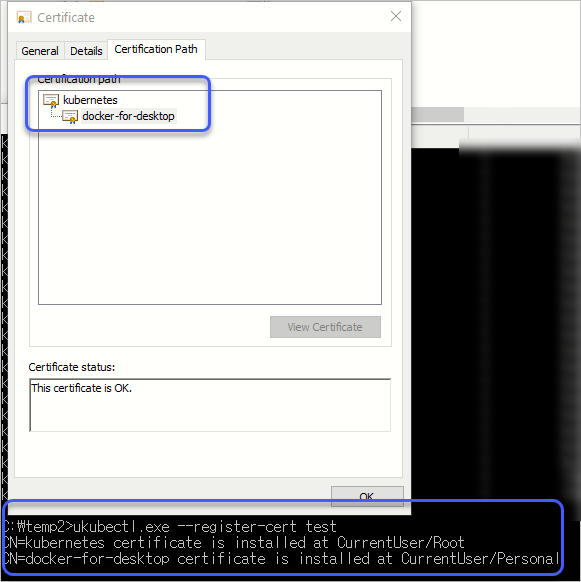C# - Kubeconfig의 token 설정 및 인증서 구성을 자동화하는 프로그램
지난 글에 k8s dashboard의 Kubeconfig 파일 로그인을 설명했었는데요,
Docker Desktop for Windows - k8s dashboard의 Kubeconfig 로그인 및 Skip 방법
; https://www.sysnet.pe.kr/2/0/12592
이를 위한 과정을 전에 설명했던 프로그래밍으로,
C# - kubectl 명령어 또는 REST API 대신 Kubernetes 클라이언트 라이브러리를 통해 프로그래밍으로 접근
; https://www.sysnet.pe.kr/2/0/12594
자동화하는 것도 가능합니다. 실제로 해볼까요? ^^ 이를 위해 우선, secret token 값을 구하는 과정을 다음과 같이 코딩할 수 있습니다.
string path = Environment.ExpandEnvironmentVariables(@"%USERPROFILE%\.kube\config");
KubernetesClientConfiguration config = KubernetesClientConfiguration.BuildConfigFromConfigFile(path);
IKubernetes client = new Kubernetes(config);
string defaultSecret = GetDefaultSecret(client);
/* defaultSecret == "eyJhbGciOiJSUzI...[생략]...lzn1lGmAh1w" */
private static string GetDefaultSecret(IKubernetes client)
{
var list = client.ListNamespacedSecret("default");
foreach (var item in list.Items)
{
if (item.Data.ContainsKey("token"))
{
return Encoding.UTF8.GetString(item.Data["token"]);
}
}
return string.Empty;
}
이제, 구한 값을 kubeconfig 파일에 써넣어야 하는데요, 여기서 아쉬운 점이 있다면 "KubernetesClientConfiguration" 타입은 kubeconfig 파일을 오직 로딩만 할 수 있다는 것입니다. 저장 기능은 없으니, 이 부분은 해당 yaml 파일을 로드해서 수정하거나 어쩔 수 없이 기존 kubectl 명령어에 얹어서 실행해야 합니다.
제 경우에는 그냥 kubectl을 실행하는 것으로 해결했습니다.
string path = Environment.ExpandEnvironmentVariables(@"%USERPROFILE%\.kube\config");
KubernetesClientConfiguration config = KubernetesClientConfiguration.BuildConfigFromConfigFile(path);
string userName = GetCurrentContextUserName(path, config.CurrentContext);
RunKubectl($"config set-credentials {userName} --token=\"{defaultSecret}\"");
private static int RunKubectl(string arg)
{
ProcessStartInfo psi = new ProcessStartInfo();
psi.FileName = "kubectl";
psi.Arguments = arg;
using (Process proc = Process.Start(psi))
{
proc.WaitForExit();
return proc.ExitCode;
}
}
private static string GetCurrentContextUserName(string kubeconfigPath, string currentConetxtName)
{
K8SConfiguration k8sConfig = KubernetesClientConfiguration.LoadKubeConfig(kubeconfigPath);
foreach (var item in k8sConfig.Contexts)
{
if (item.Name == currentConetxtName)
{
return item.ContextDetails.User;
}
}
return null;
}
만드는 김에 아래의 글에서,
Docker Desktop for Windows - kubectl proxy 없이 k8s 대시보드 접근 방법
; https://www.sysnet.pe.kr/2/0/12593#cert
"c) API Server를 활용하는 방법"을 위해 사전 작업이었던 openssl과 shell 명령어로 다뤘던 것을 한 번에 끝내는 방법도 다뤄보겠습니다. 그런데 사실 이 과정은 이미 다음의 글에서 다뤘습니다.
C# - 인증서 및 키 파일로부터 pfx/p12 파일을 생성하는 방법
; https://www.sysnet.pe.kr/2/0/12599
그렇게 해서 이번 글에 설명한 예제 코드를 다음의 github repo에 남겼으니, ^^
Utilities/ukubectl/
; https://github.com/stjeong/Utilities/tree/master/ukubectl
빌드해서(혹은
다운로드해서) 다음과 같이 실행하면,
C:\temp2> ukubectl.exe --register-cert test
인증서 관리자에서 CurrentUser의 Root와 Personal에 각각 CA 인증서와 개인키까지 담고 있는 사용자 인증서를 볼 수 있습니다.

아울러 Access Token도 간단하게 명령어 하나로 끝낼 수 있고!
C:\temp2> ukubectl.exe --set-default-token
[이 글에 대해서 여러분들과 의견을 공유하고 싶습니다. 틀리거나 미흡한 부분 또는 의문 사항이 있으시면 언제든 댓글 남겨주십시오.]